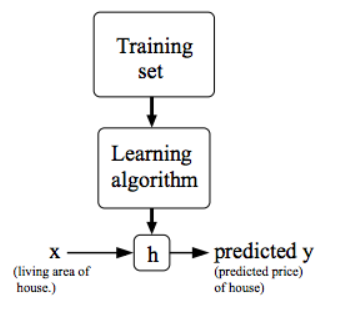【吴恩达】引言、线性回归、多项式回归
Machine Learning
Chapter1 Introduction
What is machine learning
A computer program is said to learn from experience E with respect to some task T and some performance measure P, if its performance on T, as measured by P, improves with experience E.
某类任务T(task)具有性能度量P(performance),计算机程序可以从任务T的经验E(experience)中学习,提高性能P.
Machine learning algorithms can be divided into Supervised learning and Unsupervised learning.
Supervised learning
Given the label
- Classification: Discrete valued output
- regression: Continuous valued output
Unsupervised learning
Not given the label
- cluster
- cocktail party
Chapter2 Univariate Linear Regression

Model representation
Hypothesis function
hypothesis: just a terminology. Here we assume the initial expression of the model is linear(easiest, can also be quadratic or multiple order).
Cost function
Square error function: The most commanly used one for regression problems.
m means the number of data sets, i.e. the number of points in the image.
Adding \(\frac{1}{2}\) only to get a easier function after derivation, which has no effect to the optimization results.
Goal: Choose \(\theta_0,\theta_1\) so that \(J(\theta_0,\theta_1)\) is minimum
Each value group of \((\theta_0,\theta_1)\) corresponds to a different hypothesis function, and a different cost value.
\(J\) is a function with respect to \(\theta\), \(h_\theta\) is a function with respect to \(x\), the number of \(\theta\) is always more than the number of \(x\), so \(J\) always has a higher dimension than \(h_\theta\).
We use hypothesis function and original value to get cost function. Then, find the minimum cost value in cost function, so that we find the most suitable Hypothesis function to fit the original data.
Gradient descent
repeat until convergence{
for \(j=0\) and \(j=1\)
\(\alpha\) is called learning rate. If \(\alpha\) is too small, gradient descent can be slow; If \(\alpha\) is too large, gradient descent can overshoot the minimum, which may fail to converge, or even diverge.
}
note: simultaneous update. We need two temporary variables to implement this.
Cost function for linear regression is always going to be a convex function. So we needn't worry about the local optima question.
Batch Gradient Descent: each step of gradient descent uses all the training examples.
Multivariate Linear Regression
Hypothesis function
n means the number of features,i.e. the number of axis in the image. In univariate linear regression, n=1.
Cost function
Unlike univariate linear regression, here \(\theta\) and \(x\) are both vectors rather than scalers.
Gradient descent
repeat until convergence{
(simultaneously update for every \(j=0,\cdots,n\))
}
In order to make gradient descent run much faster and converge in a lot fewer iterations, here are some tricks.
Feature scaling
If the value of one feature is far larger than the other feature, then the contour of the cost function will be a bunch of skinny ovals, the gradient descent will be very slow.
Get every feature into approximately a \(-1\le x_i\le1\) range.
Mean normalization
Replace \(x_i\) with \(x_i-\mu_i\) to make features have approximately zero mean. Do not apply to \(x_0\), because \(x_0 \equiv 1\), no matter how we transform.
Learning rate
Plot the figure of cost function with respect to the number of iterations, in order to check the convergence.
- If the curve is increasing or oscillating, use smaller \(\alpha\)
- If the curve decreases too slowly, use larger \(\alpha\)
Normal equation
m examples, n features.
No need to do feature scaling.
what if \(X^TX\) is non-invertible(singular or degenerate), although we run this pretty rarely?
- Redundant features(linearly dependent). We should delete the redundant features
- Too many features(\(m\le n\)).We should delete some features, or use regularization.
Gradient descent vs Normal equation
Gradient descent
- Need to choose \(\alpha\). This means running it few times with different \(\alpha\) and seeing which works best.
- Need many iterations. This may very slow in some cases(ellipse), and need to plot J of No. iterations to check the convergence.
- Work well even when \(n\) is large.
Normal equation
- No need to choose \(\alpha\)
- No need to iterate.
- Slow when \(n\) is large(\(n>10000\)). Need to compute \((X^TX)^{-1}\), which is an (n+1)\(\times\)(n+1) matrix. Compute matrix with large dimensions takes much time, the time complexity is \(o(n^3)\).
Chapter3 Polynomial regression
Hypothesis Function
Transform the polynomial function to multivariate function. Remember to use feature scaling.
words and expressions
pseudo 伪
resort 求助
sophisticated 复杂的
quadratic 二次 cubic 三次
skinny 瘦的
ellipse oval 椭圆
skewed 歪曲的
malignant tumor 恶性肿瘤
benign tumor 良性肿瘤
lump 肿块
tragical 悲剧性的
slightly 轻微地
clump 簇、群
inventory 库存清单
cohesive 有结合力的
diabetes 糖尿病
hypothesis 假设
intuition 直觉
contour 等高线
colon 冒号
comma 逗号
whereas 鉴于、然而
susceptible 易受影响的
iterative 迭代的
commutative property 交换律
associative property 结合律
sloppy 马虎的,草率的



